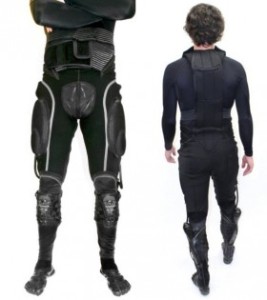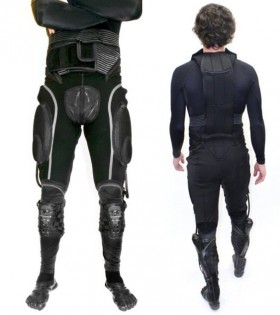
The Elderly May Toss Their Walkers for This Robotic Suit
The Elderly May Toss Their Walkers for This Robotic Suit
An early prototype of a soft exoskeleton that helps you walk could prove useful for the military and the aging population.
No one wants to walk with a walker, but age has a way of making people compromise on their quality of life. The team behind Superflex, which spun out of SRI International in May, thinks there could be another way.
The company is building wearable robotic suits, plus other types of clothing, that can make it easier for soldiers to carry heavy loads or for elderly or disabled people to perform basic tasks. A current prototype is a soft suit that fits over most of the body. It delivers a jolt of supporting power to the legs, arms, or torso exactly when needed to reduce the burden of a load or correct for the body’s shortcomings.
 The Superflex suit learns a wearer’s gate in order to kick in power when needed.
The Superflex suit learns a wearer’s gate in order to kick in power when needed.
A walker is a “very cost-effective” solution for people with limited mobility, but “it completely disempowers, removes dignity, removes freedom, and causes a whole host of other psychological problems,” SRI Ventures president Manish Kothari says. “Superflex’s goal is to remove all of those areas that cause psychological-type encumbrances and, ultimately, redignify the individual.”
A senior with shaky hands could use the technology to achieve a steadier grip. Or a soldier could wear the suit to conserve energy while carrying a heavy pack.
Superflex’s suit uses a suite of sensors to learn wearers’ individual movement styles and safely kicks in power at the exact moment it is needed. As a result, the suit’s batteries last much longer than they would if they were fully powering each step or motion (though the company would not state how long the batteries do last). This is important because even as computing has advanced rapidly, batteries and motors have remained bulky and limited in their power.
“For an elderly or general population with reduced mobility due to injury or disease, [the suit] could restore mobility and independence and therefore increase the quality of life,” says Volker Bartenbach, an exoskeleton researcher at ETH Zurich, who is not involved with Superflex. For example, he says, it could enable people to climb stairs again. A suit like this could also increase productivity and reduce the risk of injury in the workplace, Bartenbach says.
Other powered exoskeletons are also under development for medical and industrial applications. The $40,000 Phoenix suit is designed to help someone totally paralyzed from the waist down walk again. Superflex, which doesn’t aim to provide full mobility, is joined in its category by a wide variety of suits from institutions like Hyundai and Harvard’s Wyss Institute. It stands apart for its compact size and unique way of learning each wearer’s stride in order to provide extra power at the right moment.
Kothari couldn’t say how much the suit will cost or what exactly it will look like, because the company is currently looking at options for its commercialization. While it currently takes five minutes or less to put on with some practice, he believes the commercial product will take just two minutes to get into. He emphasizes that affordability has been a goal at every step of the design process. SRI International is also working on several other projects that involve powered clothing to make people’s lives easier.

Leave a Reply